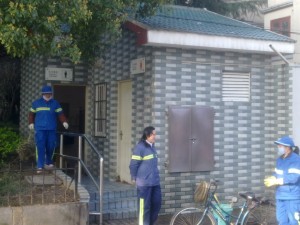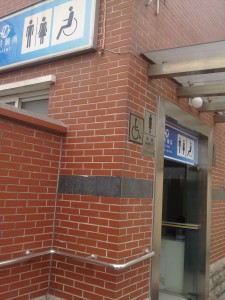Shanghai Street View: Potty Improvements

China’s economic miracle has captured global headlines for much of the last 30 years, but a much quieter revolution has also taken place in that time at the nation’s toilets. As China’s leading commercial center, Shanghai has been at the edge of this quieter revolution, which has just flushed past another milestone with the announcement of a new mobile app to help people locate the nearest public toilet. (English article)The new app uses GPS technology to locate the nearest of 8,000 public toilets now operating in Shanghai for users who feel the call of nature while walking around or driving outside. Residents won’t be able to try out the app until its official launch in May, and many foreigners may have to wait even longer since the initial version will only be in Chinese.
The new app is part of China’s ongoing campaign to clean up its toilets, which have slowly transformed over these last 30 years to relatively friendly places. That’s a strong contrast from the past, when public toilets were generally places you tried to avoid altogether, or to use as quickly as possible and only in extreme emergencies while holding your nose.

The ongoing campaign to make toilets more friendly made global headlines last month, when the Health Ministry released guidelines that many found amusing despite their good intentions. Those new standards said that no public restrooms could have more than 1 fly per square meter if they were indoors, and no more than 3 per square meter if they were outdoors. (English article) Perhaps some cities like Shanghai will be able to meet this standard, if they can find a way to really measure it; but I sincerely doubt that many smaller cities will be able to rise to this level, as many still operate public toilets that are little more than fly-infested holes in the ground.
As a longtime China resident, I can say with conviction that toilet-locating apps and fly-based standards were the furthest things from my mind when I lived in Beijing in the 1980s and during my frequent visits in the 90s. Nearly any foreigner who has lived in China for extended periods has his own toilet stories to tell, and I’m certainly no exception.
One of my most vivid memories came during a trip to the northern city of Harbin in the winter of 1987, where I was dismayed to learn the toilet at a local eatery was an outdoor pit where the surrounding temperature was 20 degrees below zero. On another trip to Sichuan in 1988, my sisters named the toilet in our hotel “the aqueduct” because it consisted of a trough in the floor with several low walls meant to separate different stalls.
Those toilets of yesterday have largely disappeared in recent years, especially from big cities like Beijing and Shanghai, as part a broader campaign for better sanitation. Something like this newest toilet-finding app would have been unthinkable just 20 years ago, when cellphones had yet to come to China and even having a regular wired-line phone in one’s home was considered a big luxury.
But despite the big progress, I wouldn’t be completely honest if I didn’t mention at least some of the improvements still needed to bring Shanghai’s toilets closer to global standards. For starters, many of the city’s public toilets desperately need heat during the winter, as there’s nothing worse than being exposed when the weather outside is freezing. The city’s toilets should also contain toilet paper, as not everyone always carriers around their own supply.
And lastly, both public and private toilet operators should do a better job of policing their facilities to prohibit smoking. This particular problem is one of my own pet peeves, which frequently sees people sneak into toilet stalls to smoke in buildings where smoking is prohibited. I’m sorry, smokers, but enjoying a cigarette from behind the closed door of a toilet stall is still against the rules in a non-smoking building, even if no one can see you.
Despite these remaining gripes, I still have to commend China for the steady improvements in its public toilets over the years, and hope the trend will continue. While it seems like a minor detail, the quality and accessibility of a city’s toilets are one factor that leaves a big impression on many visitors and residents, and improvement in that area will undoubtedly help Shanghai in its drive to be seen as a major international city.
